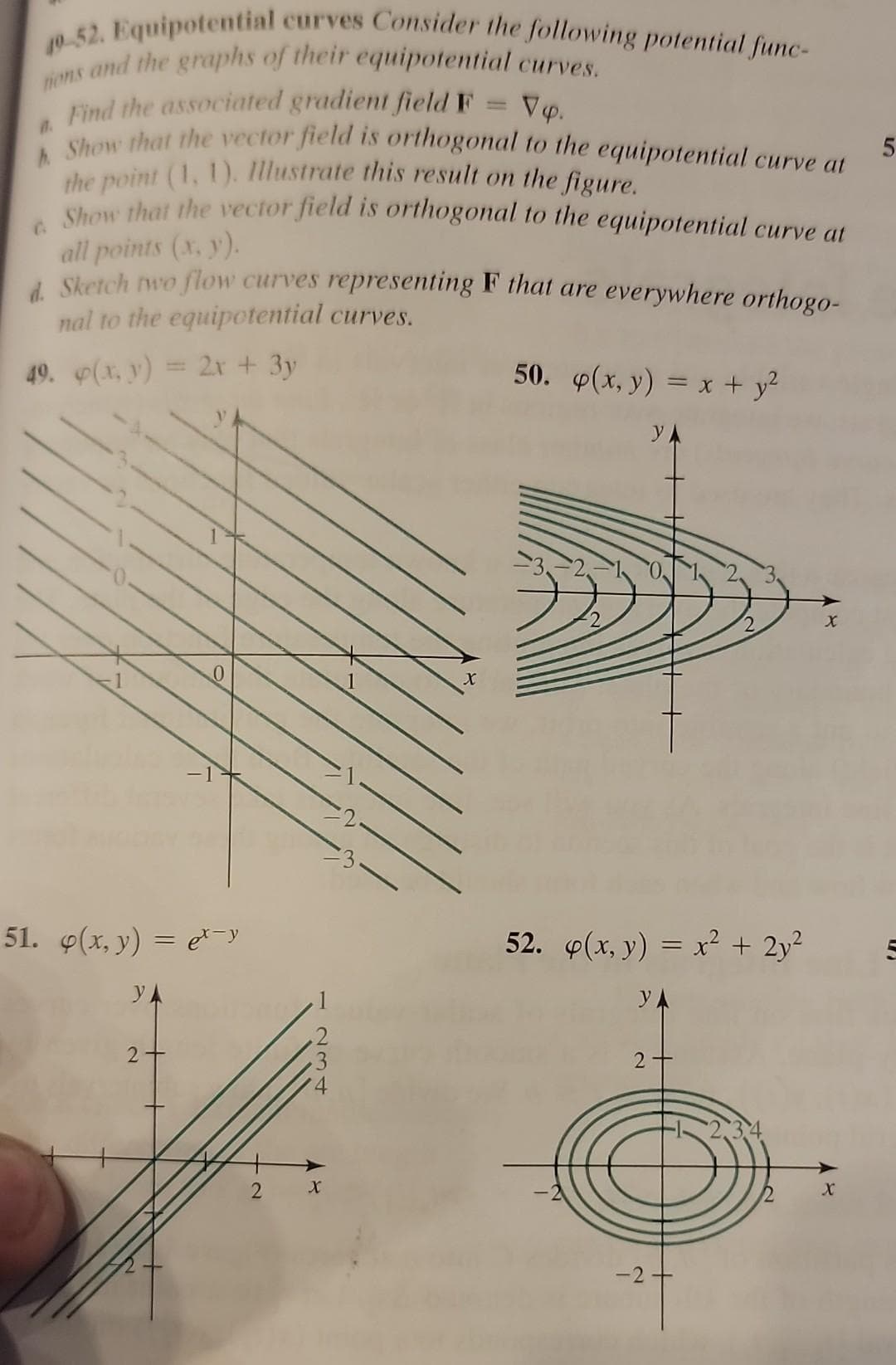49-52. Equipotential tions and the graphs of their equipotential curves. Find the associated gradient field F Vp. curves Consider the following potential func- 0. h Show that the vector field is orthogonal to the equipotential curve at the point (1, 1). Illustrate this result on the figure. Show that the vector field is orthogonal to the equipotential curve at all points (x, y). d. Sketch two flow curves representing F that are everywhere orthogo- nal to the equipotential curves. 49. p(x, y) = 2x + 3y 50. p(x, y) = x + y² 51. p(x, y) = et-y 1 X 52. p(x, y) = x² + 2y² X
49-52. Equipotential tions and the graphs of their equipotential curves. Find the associated gradient field F Vp. curves Consider the following potential func- 0. h Show that the vector field is orthogonal to the equipotential curve at the point (1, 1). Illustrate this result on the figure. Show that the vector field is orthogonal to the equipotential curve at all points (x, y). d. Sketch two flow curves representing F that are everywhere orthogo- nal to the equipotential curves. 49. p(x, y) = 2x + 3y 50. p(x, y) = x + y² 51. p(x, y) = et-y 1 X 52. p(x, y) = x² + 2y² X
Algebra & Trigonometry with Analytic Geometry
13th Edition
ISBN:9781133382119
Author:Swokowski
Publisher:Swokowski
Chapter6: The Trigonometric Functions
Section6.6: Additional Trigonometric Graphs
Problem 77E
Related questions
Question
Stuck on parts b-d of #52
Please solve 52 , b-d all question and neat handwriting

Transcribed Image Text:40-52. Equipotential curves Consider the following potential func-
tions and the graphs of their equipotential curves.
Find the associated gradient field F
Vp.
0.
h Show that the vector field is orthogonal to the equipotential curve at
the point (1, 1). Illustrate this result on the figure.
Show that the vector field is orthogonal to the equipotential curve at
all points (x, y).
d. Sketch two flow curves representing F that are everywhere orthogo-
nal to the equipotential curves.
49. p(x, y) = 2x + 3y
50. p(x, y) = x + y²
51. p(x, y) = e-y
YA
2
2
234
X
1
X
52. p(x, y) = x² + 2y²
YA
2+
-2 +
2
X
5
Expert Solution
This question has been solved!
Explore an expertly crafted, step-by-step solution for a thorough understanding of key concepts.
Step by step
Solved in 3 steps with 3 images

Recommended textbooks for you

Algebra & Trigonometry with Analytic Geometry
Algebra
ISBN:
9781133382119
Author:
Swokowski
Publisher:
Cengage

Algebra and Trigonometry (MindTap Course List)
Algebra
ISBN:
9781305071742
Author:
James Stewart, Lothar Redlin, Saleem Watson
Publisher:
Cengage Learning

Algebra & Trigonometry with Analytic Geometry
Algebra
ISBN:
9781133382119
Author:
Swokowski
Publisher:
Cengage

Algebra and Trigonometry (MindTap Course List)
Algebra
ISBN:
9781305071742
Author:
James Stewart, Lothar Redlin, Saleem Watson
Publisher:
Cengage Learning